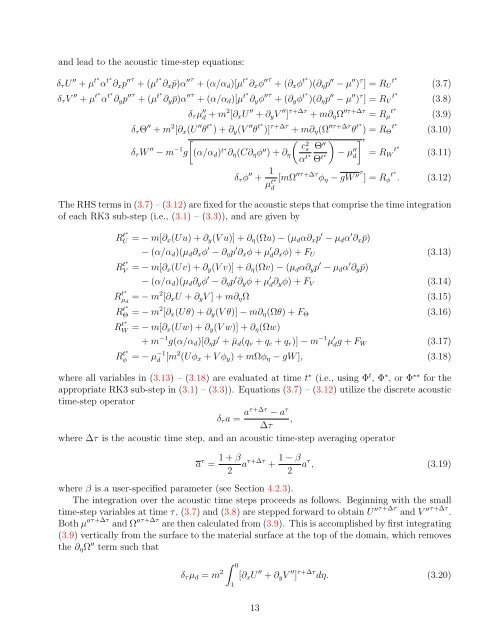Advanced Research WRF (ARW) Technical Note - MMM - University ...
Advanced Research WRF (ARW) Technical Note - MMM - University ...
Advanced Research WRF (ARW) Technical Note - MMM - University ...
You also want an ePaper? Increase the reach of your titles
YUMPU automatically turns print PDFs into web optimized ePapers that Google loves.
and lead to the acoustic time-step equations:<br />
δτU ′′ + µ t∗<br />
α t∗<br />
∂xp ′′τ t<br />
+ (µ ∗<br />
∂x¯p)α ′′τ<br />
+ (α/αd)[µ t∗<br />
∂xφ ′′τ<br />
+ (∂xφ t∗<br />
)(∂ηp ′′ − µ ′′ ) τ ] = RU t∗<br />
δτV ′′ + µ t∗<br />
α t∗<br />
∂yp ′′τ t<br />
+ (µ ∗<br />
∂y ¯p)α ′′τ<br />
+ (α/αd)[µ t∗<br />
∂yφ ′′τ<br />
+ (∂yφ t∗<br />
)(∂ηp ′′ − µ ′′ ) τ ] = RV t∗<br />
δτΘ ′′ + m 2 [∂x(U ′′ θ t∗<br />
δτW ′′ − m −1 g<br />
δτµ ′′<br />
d + m 2 [∂xU ′′ + ∂yV ′′ ] τ+∆τ + m∂ηΩ ′′τ+∆τ = Rµ t∗<br />
) + ∂y(V ′′ θ t∗<br />
<br />
(α/αd) t∗∂η(C∂ηφ ′′ <br />
c2 s<br />
) + ∂η<br />
αt∗ Θ ′′<br />
Θt∗ <br />
δτφ ′′ + 1<br />
µ t∗<br />
)] τ+∆τ + m∂η(Ω ′′τ+∆τ θ t∗<br />
d<br />
− µ ′′<br />
d<br />
τ<br />
) = RΘ t∗<br />
= RW t∗<br />
(3.7)<br />
(3.8)<br />
(3.9)<br />
(3.10)<br />
(3.11)<br />
[mΩ ′′τ+∆τ φη − gW ′′τ ] = Rφ t∗<br />
. (3.12)<br />
The RHS terms in (3.7) – (3.12) are fixed for the acoustic steps that comprise the time integration<br />
of each RK3 sub-step (i.e., (3.1) – (3.3)), and are given by<br />
R t∗<br />
U = − m[∂x(Uu) + ∂y(V u)] + ∂η(Ωu) − (µdα∂xp ′ − µdα ′ ∂x¯p)<br />
− (α/αd)(µd∂xφ ′ − ∂ηp ′ ∂xφ + µ ′ d∂xφ) + FU<br />
R t∗<br />
V = − m[∂x(Uv) + ∂y(V v)] + ∂η(Ωv) − (µdα∂yp ′ − µdα ′ ∂y ¯p)<br />
− (α/αd)(µd∂yφ ′ − ∂ηp ′ ∂yφ + µ ′ d∂yφ) + FV<br />
(3.13)<br />
(3.14)<br />
R t∗<br />
µd = − m2 [∂xU + ∂yV ] + m∂ηΩ (3.15)<br />
R t∗<br />
Θ = − m 2 [∂x(Uθ) + ∂y(V θ)] − m∂η(Ωθ) + FΘ<br />
R t∗<br />
W = − m[∂x(Uw) + ∂y(V w)] + ∂η(Ωw)<br />
+ m −1 g(α/αd)[∂ηp ′ + ¯µd(qv + qc + qr)] − m −1 µ ′ dg + FW<br />
(3.16)<br />
(3.17)<br />
R t∗<br />
φ = − µ −1<br />
d [m2 (Uφx + V φy) + mΩφη − gW ], (3.18)<br />
where all variables in (3.13) – (3.18) are evaluated at time t ∗ (i.e., using Φ t , Φ ∗ , or Φ ∗∗ for the<br />
appropriate RK3 sub-step in (3.1) – (3.3)). Equations (3.7) – (3.12) utilize the discrete acoustic<br />
time-step operator<br />
δτa = aτ+∆τ − aτ ,<br />
∆τ<br />
where ∆τ is the acoustic time step, and an acoustic time-step averaging operator<br />
a τ =<br />
1 + β<br />
2 aτ+∆τ 1 − β<br />
+<br />
2 aτ , (3.19)<br />
where β is a user-specified parameter (see Section 4.2.3).<br />
The integration over the acoustic time steps proceeds as follows. Beginning with the small<br />
time-step variables at time τ, (3.7) and (3.8) are stepped forward to obtain U ′′τ+∆τ and V ′′τ+∆τ .<br />
Both µ ′′τ+∆τ and Ω ′′τ+∆τ are then calculated from (3.9). This is accomplished by first integrating<br />
(3.9) vertically from the surface to the material surface at the top of the domain, which removes<br />
the ∂ηΩ ′′ term such that<br />
δτµd = m 2<br />
0<br />
[∂xU<br />
1<br />
′′ + ∂yV ′′ ] τ+∆τ dη. (3.20)<br />
13
















